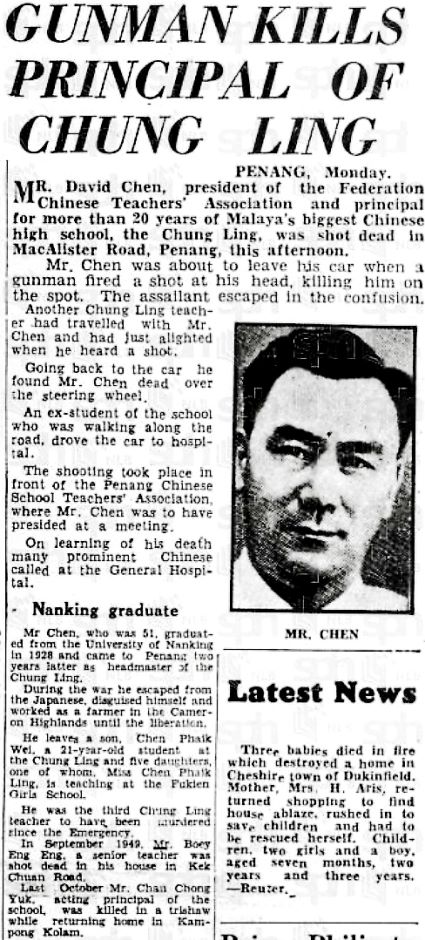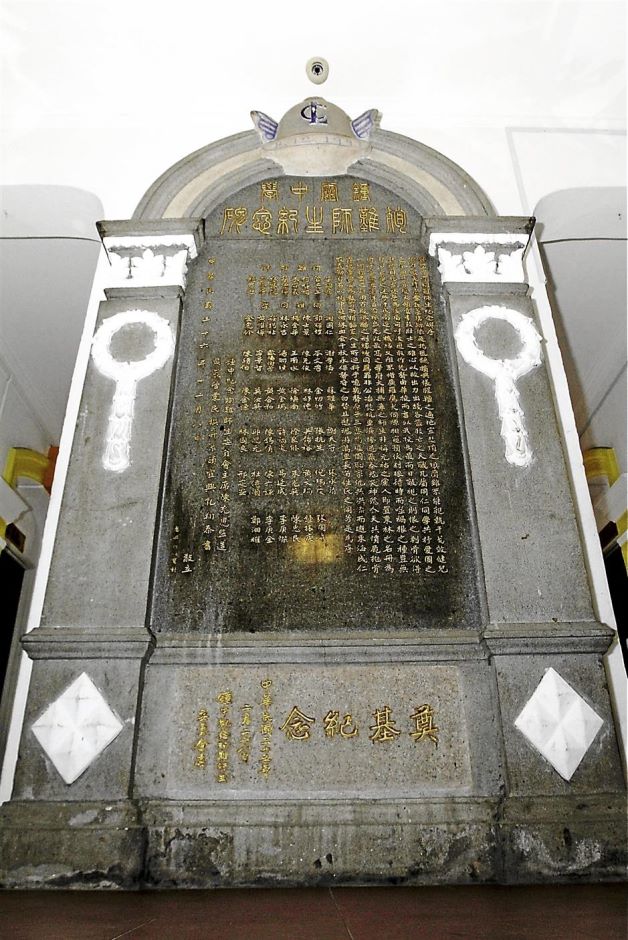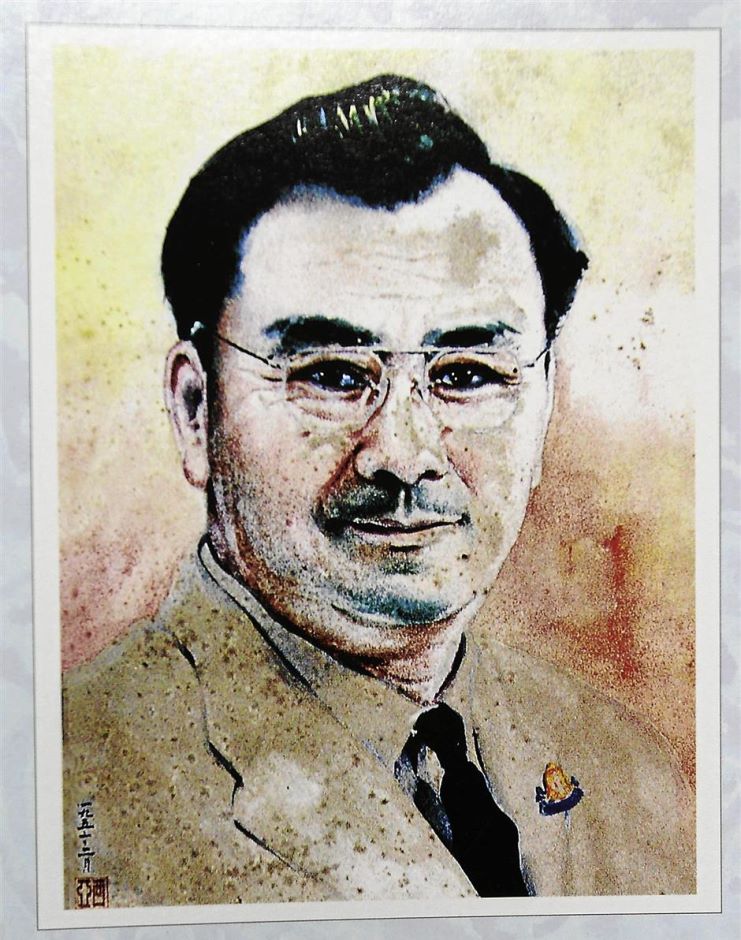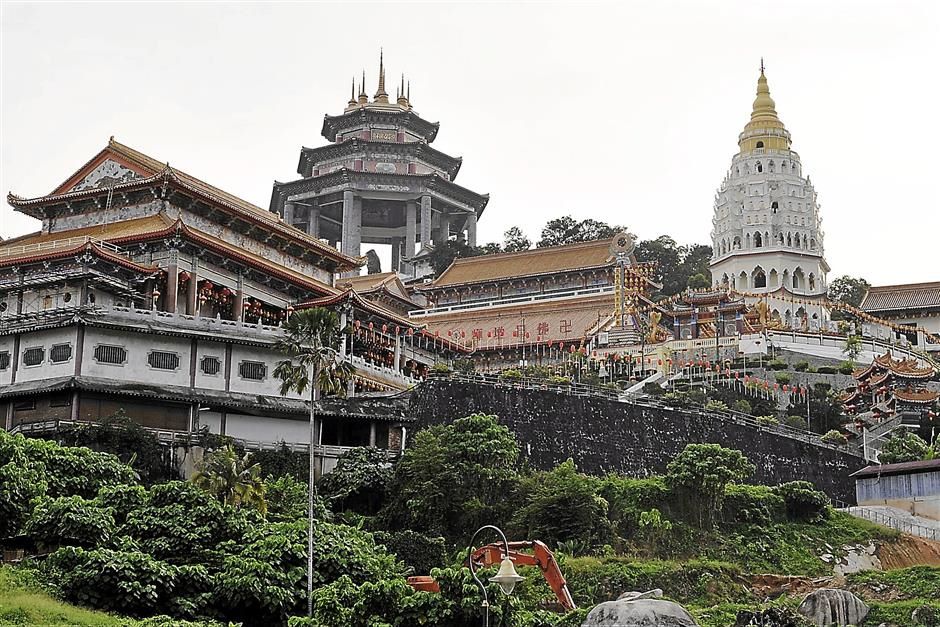
In remembrance: A residential neighbourhood, located just next to the school, has been rightly named Taman David Chen in his honour.
THE screaming headline on the front page of The Straits Times on Feb 5, 1952 was “Gunman Kills Principal of Chung Ling”.
It was no ordinary murder because the victim in question was David Chen Chong Ern, the principal of the country’s biggest and most famous Chinese school, the Chung Ling High School.
Chen, who hailed from Suzhou, China, and a graduate of the prestigious University of Nanking, was at that time also the president of the Federation of Chinese Teachers Association.
He was shot dead at Macalister Road in front of the Penang Chinese School Teachers Association, where he was about to chair a meeting.
The assailant shot Chen in the head before he could even alight from his car with his other colleagues.
Chen had travelled to Malaya in 1930 to join Chung Ling High School, founded by supporters of the Kuomintang party, but his anti-communist views irked members of the Communist Party of Malaya, especially his stand in education.
In his dissertation, “Chinese-ness in Malaysian Chinese Education Discourse: The Case of Chung Ling High School”, Jin Pei Goh wrote that the school was influenced by the Chinese nationalist movement in China.
The fate of the school, the academician wrote, was connected to the turbulent years of the Sino-Japanese war, the Chinese civil war in 1927-1945 and the formation of the People’s Republic of China.
During the troubled years of the Emergency, Chen was the third Chung Ling teacher to be killed.
In 1949, a teacher, Boey Eng Eng, was shot dead in front of his house at Kek Chuan Lane, off Chulia Street and in 1951, Chan Chong Yuk, who was the school’s acting principal, was killed on his way to his Kampong Kolam home.
Those were the years of living dangerously, where Chinese community leaders, teachers and police officers who were deemed to go against the CPM were high on the hit list.
In the case of Chen, there are those who believed in the conspiracy theory that the British intelligence service was responsible for his murder. Apparently, they were uncomfortable with his push for Chinese education while the British preferred the mission schools, where English was the medium of instruction.
A year after Chen’s killing, two persons were charged for his murder. They were Lee Khuan Koa and Chan Kwong Siew, both 22 years old, but ironically, the news was just a filler or a simple short news story on page 4.
In 1954, The Straits Times reported on a ceremony that was held to commemorate the assassination of Chen.
In the article, it reported that three men were involved in the shooting. One was said to have committed suicide when cornered, another “fatally wounded trying to avoid recapture after a gaol break” and the third man convicted in Malacca in 1953 and hanged.
According to an article written by Timothy Tye of Penang Travel Tips, Chung Ling School, as it was originally known, was founded by supporters of Chinese nationalist Dr Sun Yat Sen, among them Tan Sin Cheng, Khoo Beng Cheang, Chu Yeo Aik, Khaw Seng Lee and Lim Joo Teik.
The school, he wrote, was originally located at 18, Malay Street and in 1918, Chung Ling School moved to occupy 65, Macalister Road, which was the Penang Philomatic Union and is today the Sun Yat Sen Memorial Hall housing the Penang Sun Yat Sen Centre.
Chung Ling School, which has produced some of the best Malaysian personalities today, finally settled at its present location in Jalan Air Itam in 1923.
The school was once a hotbed of activism against the Japanese during the Occupation, where the idealistic teachers and students suffered harsh treatment from the Japanese forces for their refusal to switch from Chinese to Japanese studies.
During the difficult years, many were executed. They paid a heavy price for their patriotism, buoyed by the events in China.
In fact, Chen, who helmed the school for 20 years, escaped to Cameron Highlands where he posed as a vegetable farmer.
Today, the school has continued to be in the limelight for producing top scorers in public examinations.
It has produced some of the best known alumni including former Penang Chief Minister Tan Sri Dr Koh Tsu Koon, former Senate president Tan Sri Michael Chen, former Nanyang University vice-chancellor Dr Wu Teh Yao, former Singapore minister Lee Khoon Choy and controversial financier Jho Low.
A residential neighbourhood, located just next to the school, has been rightly named Taman David Chen in his honour.
Chen is likely to be known by students of the school but he is non-existent in the history books on Penang. For the English-educated, he is also likely to be an unfamiliar name.
But Chen surely deserves a place in the history of Penang for his contributions of over two decades to one of the best schools in the region.
For all the complexities of the school’s history and its teachers, Taman David Chen is known among foodies for a simple dish – its popular “economy fried bee hoon” – which attracts large crowds to the stall every morning.
The stall is located just opposite the Kampung Baru wet market and is known to most residents in Air Itam.
Further down the road is my family home, in Jalan Kampung Melayu, off the main thoroughfare of Jalan Air Itam.
Readers Write
L.L. Loh-Lim and L. Loh write: Thank you for your article on Cheong Fatt Tze last week. It was much appreciated. In particular, we appreciate your comments that this legendary figure in the early development of Penang — and indeed of the region — has been entirely left out of our history books.
His stunning philantrophy and critical contributions and visions in the development of the state have had scant official acknowledgement. Except for Jalan Cheong Fatt Tze, removed in the development of Komtar and hastily replaced with Carnavon Street when the Teoh Kongsi pressured the Penang Municipal Council (MPPP), no one has ever highlighted the significance of the man, before the restoration of his home in Leith Street.
Besides building the first Chinese school in South-East Asia in Penang and helping Sun Yat Sen overthrow the Manchus, Cheong Fatt Tze aka Chang Pi-Shih aka Thio Tiaw Siat donated extensively to schools, hospitals, temples and all worthy charities of the day.
Among other things, he was:
●the main donor of the Kek Lok Si (where his larger-than-life statue sits in a room apart from the statues of the lesser donors);
● one of the main donors of the Penang Free School (the donors plaque is on the wall of the current State Museum);
● the main donor of the King Edward Memorial Hospital for destitute women, setting up a trust for the premises, to be used by non-profit
organisations (currently also being used by the State Museum in Macalister Road);
● the founder of the Teoh Kongsi; and
● Vice-Consul for China in Penang and Consul-General in Singapore
In 1916, British and Dutch authorities had ordered flags to be flown at half mast on the death of this exemplar of hard work and vision, and yet, like you, we students of St Xavier’s were given neither knowledge of the man nor the mansion in Leith Street.
It was reputed to be his favourite home because it was where his favourite wife No. 7 resided and where his last son was born when he
was aged 74.
In 1989, the mansion came on the market upon the death of this son.









